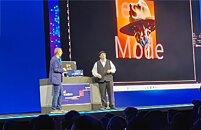- Joined
- Oct 9, 2007
- Messages
- 47,233 (7.55/day)
- Location
- Hyderabad, India
| System Name | RBMK-1000 |
|---|---|
| Processor | AMD Ryzen 7 5700G |
| Motherboard | ASUS ROG Strix B450-E Gaming |
| Cooling | DeepCool Gammax L240 V2 |
| Memory | 2x 8GB G.Skill Sniper X |
| Video Card(s) | Palit GeForce RTX 2080 SUPER GameRock |
| Storage | Western Digital Black NVMe 512GB |
| Display(s) | BenQ 1440p 60 Hz 27-inch |
| Case | Corsair Carbide 100R |
| Audio Device(s) | ASUS SupremeFX S1220A |
| Power Supply | Cooler Master MWE Gold 650W |
| Mouse | ASUS ROG Strix Impact |
| Keyboard | Gamdias Hermes E2 |
| Software | Windows 11 Pro |
Intel at the 2023 InnovatiON event surprised audiences with a live demo of a reference notebook powered by a Core "Lunar Lake" processor. What's surprising about this is that "Lunar Lake" won't come out until 2025 (at least), and succeeds not just the upcoming "Meteor Lake" architecture, but also its succeeding "Arrow Lake," which debuts in 2024. Intel is expected to debut "Meteor Lake" some time later this year. What's also surprising is that Intel has proven that the Intel 18A foundry node works. The Compute tile of "Lunar Lake" is expected to be based on Intel 18A, which is four generations ahead of the current Intel 7, which will be succeeded by Intel 4, Intel 3, and Intel 20A along the way.
The demo focused on the generative AI capabilities of Intel's third generation NPU, the hardware backend of AI Boost. Using a local session of a tool similar to Stable Diffusion, the processor was made to generate the image of a giraffe wearing a hat; and a GPT program was made to pen the lyrics of a song in the genre of Taylor Swift from scratch. Both tasks were completed on stage using the chip's NPU, and in timeframes you'd normally expect from discrete AI accelerators or cloud-based services.


View at TechPowerUp Main Site | Source
The demo focused on the generative AI capabilities of Intel's third generation NPU, the hardware backend of AI Boost. Using a local session of a tool similar to Stable Diffusion, the processor was made to generate the image of a giraffe wearing a hat; and a GPT program was made to pen the lyrics of a song in the genre of Taylor Swift from scratch. Both tasks were completed on stage using the chip's NPU, and in timeframes you'd normally expect from discrete AI accelerators or cloud-based services.


View at TechPowerUp Main Site | Source







